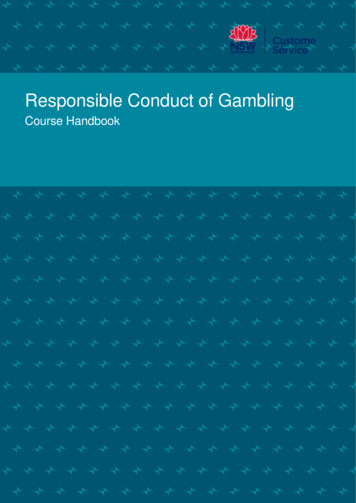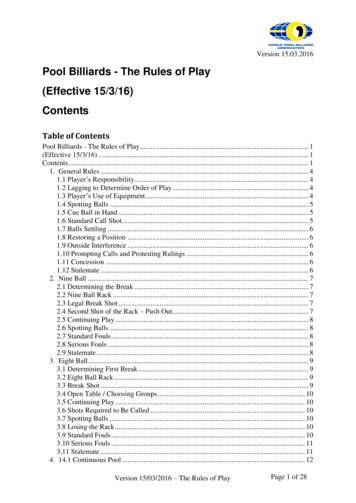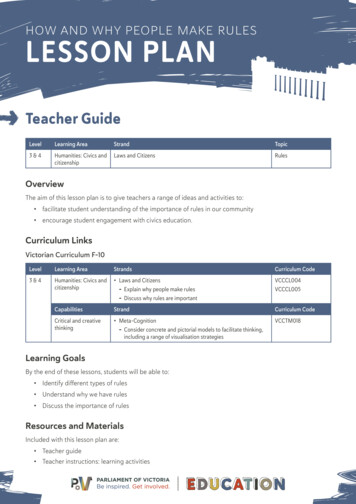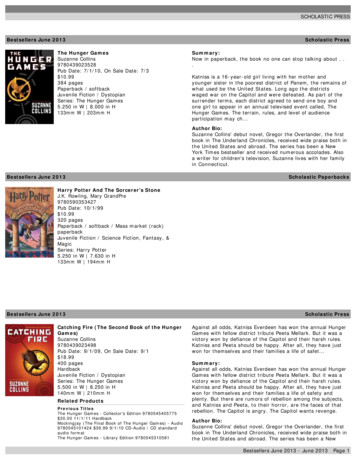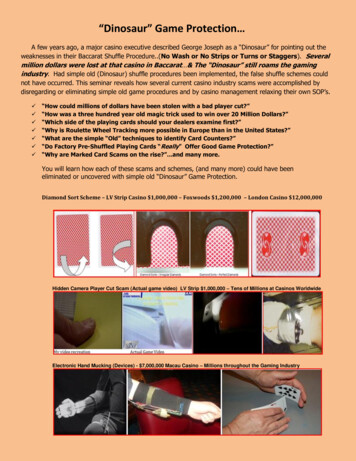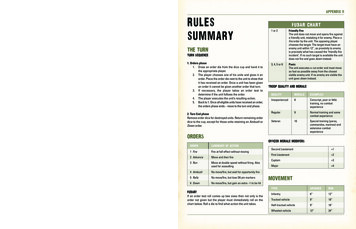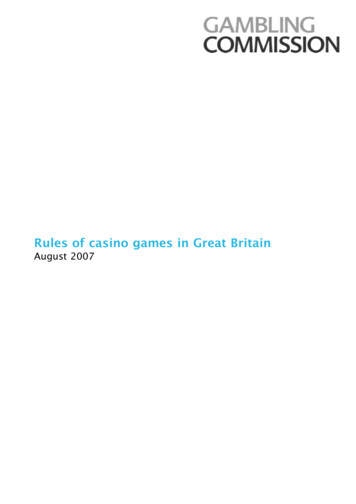
Transcription
Rules of casino games in Great BritainAugust 2007
Contents1.Introduction32.General Rules73.Roulette94.Blackjack155.Three Card Poker246.Punto Banco287.Casino Stud Poker358.Dice/Craps409.Sic Bo4610.Big Six (Wheel of Fortune)5011.Texas Hold ’Em Poker5312.Let it Ride6813.Pai Gow Poker751
1 Introduction1.1The Gambling Act 2005 (the Act) gives the Gambling Commission (theCommission), as part of its statutory role, the power to attach to any casinooperating licence conditions which specify the types of casino game that can bemade available. The Commission may also specify rules for casino games or anyequal chance game played in a casino.1.2In June, the Commission published the document, Licence Conditions and Codes ofPractice (LCCP June 2007). That document contains the conditions and codes thatwill apply to each of the sectors the Commission will regulate under the Act.1.3LCCP (June 2007) explains that non-remote casino operating licensees must onlyoffer or permit to be played certain games that appear on the list of approvedcasino games. There is one exception to this; games may be made available for aspecified period in accordance with a Commission approved trial of a proposednew game. LCCP (June 2007) also set out that licensees must follow any rules forthe playing of approved casino games, or other games of chance, as may beprescribed by the Commission.1.4The Commission stated that those casino games permitted in casinos prior to 1September 2007 will automatically be included on the list of approved gamesunder the Act, which will come into force on 1 September 2007. Followingdiscussion with the industry it has been decided that Baccarat (banque), Cheminde Fer, and Super Pan 9 should not be included on the approved list as these areno longer played in British casinos.Background1.51.6In September 2006 the Commission consulted on the types and rules of casinogames. The Commission’s approach was to: make use of existing standards and arrangements that remain useful andapplicable under the new legislation; discard elements which do not fit in with the Commission’s general approachto guidance and standards under the new legislation; and discard elements that will sit better in other guidance or codes beingproduced.As part of the consultation the British Casino Association prepared a draft of thisdocument. In addition to the consultation, a series of meetings were held withthe British Casino Association (BCA) and Casino Operators’ Association (COA) todiscuss key principles, the draft, and to ensure the final document does notcompromise any of the Commission’s three licensing objectives. TheCommission’s response to the consultation was published in February 2007.3
1.7Following on from the consultation and Commission’s response to theconsultation this document, primarily written by the BCA with input from the COA,has been approved and published by the Commission.Scope of the document1.8This document sets out the rules, including layouts, odds and any side bets, foreach game on the list of approved games, or approved for trial.1.9The document has been created to ensure a consistent approach in providingcasino games in Great Britain and accordingly is aimed at casino operators.1.10The Commission has approved the games (including side wagers) that are on trialfrom 1 September 2007. The Commission will decide whether these games shouldbe included on the list of approved games when the trial period is complete. Thisdocument will be updated if these games are formally approved.1.11Any matters relating to game rules not specifically covered in this document maybe interpreted at the discretion of the operator. The Commission’s licenceconditions and codes of practice require that all operators of these games havetraining, security, procedures and systems in place to ensure that all the gamesare played in an open and fair manner.4
2. General rules2.1The following are standard non-remote casino house rules. The listed games mayonly be played for commercial gain on casino premises, licensed under the Act.How to read this document2.2The text within the shaded boxes in this document relate to games and sidewagers to be trialled from 1 September 2007 with the approval of theCommission.Trial/introduction of new games and variations toexisting games2.3Only the games detailed in this document may be played in British casinos.However, with the prior permission of the Commission, other games may beoperated, or new features to existing games added, as a trial based on the ruleslisted:a) The game or variation must be put forward to the Commission through anoperator licensed by the Commission, and made generally available for allGreat Britain operators to participate in the trial.b) The trial must only take place for a time period agreed in advance with theCommission and the new game or additional feature must be operated inaccordance with draft practices, rules and odds agreed with theCommission beforehand.c) Information as to how the game or feature is played, and the house edgeinvolved, must be made available to players within the casino to ensurethat all customers may understand the new game before participating.d) If the industry wishes to pursue the game after the trial, a formal requestmust be made to the Commission at, or towards, the end of the trialperiod, for the game to be formally included in the list of approved games.The Commission will then decide whether the game may be formallyintroduced once it has considered the results of the trial and agreed therules, minimum odds payable and maximum house edge with the industry.e) At its discretion, the Commission may approve an extension to a particulartrial. This might be, for example, to allow the game to continueuninterrupted between the end of the trial period and its formal adoptioninto this document, or otherwise to enable further information to begathered and assessed before deciding whether to formally adopt thegame.5
f)If the conduct of the game causes concern to the Commission at any timeafter the trial has commenced, play must be discontinued, either at theend of the trial period, or within a reasonable time otherwise agreed withthe Commission.g) Alternatively, if the industry itself does not wish to pursue the game orvariation, for whatever reason, play may be discontinued at any pointwithin the trial period. Operators must notify the Commission if and whenany trial is formally abandoned by the industry.h) Any application to trial or approve a new game or variation may only bemade to the Commission through licensed operators. The Commission willnot accept applications made directly to them by manufacturers,proprietors or suppliers of new games unless they can provide evidencethat at least some section of the industry wishes to offer it to customers.Local temporary variations to the practices and rules2.4In certain circumstances, it is permitted to make minor variations to the rulesdetailed in this document on a temporary and local basis. Examples might includea bonus payment or small additional feature made as part of a local promotion.Changes may only be introduced subject to the rules below:a) The Commission must be notified in writing of any amendments beforeany change is introduced, and the notification must include details as tothe occasion(s), location(s) and period(s) of time that will be applied.b) Details of the temporary amendment are to be clearly highlighted to theplayers on all tables operating the game concerned.c) If the Commission considers that a proposed variation amounts to asignificant change or additional feature to a game, it may require that thevariation instead be put forward as a formal new game or variation, inaccordance with rule 2.3 above.d) If at the end of the notified period of use, the local operator wishes tointroduce the variation on a permanent basis, they may then apply to theCommission for the change to be formally approved as an agreed variationto the game concerned, and added to this document accordingly.e) Approval is not required for an operator to offer odds that are higher thanthe minimum odds prescribed in this document (ie offering a better returnto the player). However, when odds other than the prescribed minimumodds or pay tables given in this document are offered, a sign or noticemust be displayed at the table or tables concerned, including the houseedge, so that players are made aware of this.6
The bank2.5The following rules apply to ALL games listed in this document and cannot bevaried:a) no person other than the holder of a licence under the Gambling Act 2005for the premises where the game is played shall have any share or interestin the bank;b) the bank shall be held by the licence holder or a person acting inpursuance of a service agreement on their behalf; andc) all wagers will be made with the bank.Fully and partly automated casino games2.6ALL equipment used in fully and partly automated casino games must complywith technical standards set by the Commission as stated in the document, Bingoand Casino Equipment Technical Requirements, published on 1 June 2007. Rulesof such games cannot vary from those set out in this document without priorconsent from the Commission.Progressive side wagers2.7At the licence holder’s discretion, a casino may introduce an additional featureinto any game listed within this document, namely a ‘Progressive Jackpot’ wager,subject to specific rules and odds being detailed for that wager in the sectionrelating to the game concerned. In such cases, the following standard rules willapply wherever a progressive jackpot wager is applied:a) operators will have systems and procedures in place to account formalfunctions and technical faults during the operation of the game;b) at least 70% of the total value of the progressive jackpot wagers placed at alltables, within the premises and at any tables on other premises, which are linkedfor the purposes of the progressive jackpot, shall be added to a cumulativeprize fund (referred to in these rules as the ‘Progressive Jackpot Meter’);c) a licence holder may apply additional sums to the progressive jackpotmeter (the Jackpot ‘seed’) from its own funds;d) equipment used to play the progressive wager must conform to thetechnical standards stated in the document, Bingo and Casino EquipmentTechnical Requirements, published on 1 June 2007 by the Commission;e) operators must have procedures in place to account for the possibility ofmultiple wins occurring at the same time, either on the same table, samepremises or premises located elsewhere that are linked into the sameprogressive jackpot meter;f)operators must have procedures and security systems in place to ensure theintegrity of the funds held on the progressive jackpot meter, and to ensurethat any wins can be substantiated to the satisfaction of the Commission; andg) a sign or notice must be displayed at each participating table showing thecurrent progressive jackpot meter total.7
Minimum odds and pay tables2.8Odds detailed in this document refer to the minimum odds that must be offeredto players within a game. As detailed in rule 2.4e, more favourable odds may beoffered to the player, on a permanent or temporary basis, provided the details areclearly displayed at the table.2.9However, whilst the minimum odds permissible for each individual wager aredetailed in this document, operators may wish to change the whole pay table,rather than simply adjust one or more individual odds. This is in order to balancethe house edge across the whole range of odds being applied. It is acceptable toreplace complete pay tables in this way provided:a) the individual odds used within a pay table are not less than the individualminimum odds given within this document;b) house edge details relating to every pay table used in a particular premisesare made clearly available to players;c) for the benefit of players, a sign or notice is displayed at each relevantgaming tables indicating which pay table is being used, so that playersmay compare the given odds against details of the house edge otherwisemade available within the premises; andd) where a pay table is used that increases the minimum odds, but isotherwise not one of the pre-determined tables prescribed in both thisdocument and the House Edge leaflet, the sign or notice also shows therevised house edge for the game resulting from the revised pay table.2.10In some cases, the minimum odds given in this document serve only to show thelowest permitted odds, drawn from all of the pay tables listed for that game. As aresult, the minimum odds are not always in themselves a well-balanced pay table.In such cases, this fact is indicated in the description of the minimum odds withinthis document, with a recommendation that one of the given pay tables is used.8
3. RouletteThe table layouts3.1Figures 1 and 2 show examples of the style of game layouts that may be offeredto the players. They also illustrate the full range of bets available, and theposition that such bets must be placed on the layout, in accordance with the listgiven in paragraph 3.2.Figure 1: American rouletteFigure 2: French roulette9
3.2Any wager in relation to this game shall be payable, if won, at a minimum andwith the odds indicated below:American term3.3French termMinimum oddsA. Straight Up – one specific numberEn Plein35 to 1B. Split – one of two specific numbersA Cheval17 to 1C. Street – one of three specific numbersEn Transversale11 to 1D. Corner – one of four specific numbersEn Carré8 to 1E. First Four – one of numbers 0,1,2,3Quatre Premiers8 to 1F. Six Line – one of six specific numbersSixain5 to 1G. Column – one of 12 specific numbersin a rowSur une Colonne2 to 1H. Dozen – one of 12 specific numbersin a blockSur une Douzaine2 to 1I.Red or Black – one of 18 specific numbers Rouge ou Noir1 to 1J.Odd or Even – one of 18 specific numbers Impair ou Pair1 to 1K. Low or High – one of 18 specific numbers Manque ou Passe1 to 1L. Split Columns – one of 24 specificnumbers in a rowA Cheval surDeux Colonnes1 to 2M. Split Dozens – one of 24 specificnumbers in a blockA Cheval surDeux Douzaines1 to 2When the winning number is zero:a) wagers placed on zero, or combination of zero with one, two and/or three,shall win at odds in accordance with rule 3.2;b) half of each wager on any even money chance shall be lost and the remaininghalf returned to the player; andc) the whole of all other wagers shall be lost.3.4It is not a requirement that all wagers are made available on any particular table.However, no variation may be considered in addition to the wagers and minimumodds given in rule 3.2, other than in accordance with the rules detailed in section2.3 and 2.4.The wheel3.5Other than any permitted variations detailed in rule 3.11 onwards, or otherwise inaccordance with the rules detailed in section 2.3 and 2.4, the wheel used to playroulette shall have 37 equal sized compartments with one marked zero and theothers marked 1 to 36, coloured alternately red and black, and in the samesequence as shown in Figure 3 below.10
Figure 3: The wheel3.6The ball shall be spun in the opposite direction to the wheel.3.7Operators must have procedures in place to ensure the security and integrity ofthe wheel. The wheel must comply with the standards set in the document, Bingoand Casino Equipment Technical Requirements, published on 1 June 2007 by theCommission.General rules3.8Wagers orally declared shall be accepted only if accompanied by the placing ofsufficient chips, wheel checks or cash on the table to cover the wager and verballyconfirmed by the dealer.3.9Each player shall be responsible for the positioning of their own wager or wagerson the table, whether or not they are assisted by the dealer. The player mustensure that any instructions given are correctly carried out. Wagers shall besettled strictly in accordance with the position of chips (or as orally declared andconfirmed) when the ball falls to rest in a compartment of the wheel.3.10The maximum and minimum wagers permitted shall be shown on a noticeprominently displayed at the table. Partnerships with a view to exceeding themaximum stake shall not be permitted.Permitted variations to roulette3.11Symbols other than the numbers 0-36 may be permitted on the wheel and layoutwithin a game of roulette provided the order in which they appear on the wheel,and overall impact on the game, are the same as if they were numbers usedwithin the standard rules of the game, as detailed in this section.11
Roulette Rage side wager3.12It is at the discretion of the licence holder whether or not to offer an additionalfeature called ‘Roulette Rage’ as an additional wager within a standard game ofroulette. The proprietor of the side wager is TCSJohnHuxley Ltd and novariations may be put forward without their prior agreement.3.13The feature shall only be made available at a table or tables marked for theprovision of the wager.3.14The Roulette Rage side wager is an optional wager that at least fiveconsecutive numbers will be spun of the same colour. Higher odds are paiddepending on the number of consecutively coloured numbers that are spun.3.15Wagers on the Roulette Rage side wager may only be placed after a differentcoloured number is spun to that spun immediately before it. For example,when a black number is spun after one or more red numbers.3.16Further wagers may not then be placed until a sequence of consecutive coloursis broken by a number of a different colour being spun, or by zero, whicheveris spun first.3.17The Roulette Rage side wager is not activated if zero is spun, which will bedeemed to bring a previous consecutive sequence to an end. New wagers mayonly then be placed after a further number has been spun following the zero,or multiple zeros.3.18When a different coloured number is spun (as per rule 3.15), the dealer willinvite all players at the table to place optional wagers on the Roulette Rageside wager, within the specified table limits. The first spin that determines thecolour for the Roulette Rage side wager will hereafter be known as the‘establishing spin’. This spin will not count towards the sequence ofconsecutive colours (ie the first number will register only if the establishingcolour is repeated on the next spin).3.19Players need not have placed any other wager within the game in order toplace a Roulette Rage side wager.3.20All Roulette Rage side wagers will be placed in the betting area marked for thepurpose by the dealer after the establishing spin. No further side wagers maybe accepted until the next establishing spin.3.21The roulette game will then continue as normal.3.22If a first number spun after the establishing spin is of the same colour, allRoulette Rage wagers will be moved into the circle marked ‘1’, other thanwhere rule 3.23 applies.3.23Operators may choose to have the current number of consecutive spinstransmitted automatically from the wheel to an electronic number display.12
Provided players are able to clearly see the current number on the display, it isnot then necessary to physically move the wagers from the betting area. Thisapplies to all subsequent spins up to 15.3.24If the next number spun is not of the same colour as the establishing spin, thenall Roulette Rage wagers will be lost and surrendered to the house. A new roundof wagers may then be accepted, in accordance with rules 3.18 and 3.19.3.25If a second number of the same colour is spun after the establishing spin, allRoulette Rage wagers will be moved into the circle marked ‘2’. The sameprocess continues on the next two spins, whereby all roulette rage wagers willbe moved into the circle marked ‘3’ or ‘4’ respectively.3.26Rule 3.24 will apply if a different coloured number, or zero, is spun on eitherthe first, second or third spin after the establishing spin. However, if the fourthspin after the establishing spin is the same colour, then all Roulette Ragewagers will win and qualify for a pay out as and when a different colour orzero is subsequently spun. The pay out will then relate to however many spinsof the same colour had occurred before the sequence was broken. Forexample, if five red numbers are spun after the establishing spin, followed bya black number, the winning wagers will be paid the odds for five consecutivecolours given in rule 3.28.3.27Wagers will only be paid out if the odds applicable for the highest number ofconsecutive spins are achieved, up to a maximum of 15, including theestablishing spin. Any consecutive spins thereafter will not be counted.Rule 3.18 will then apply as soon as a different colour is spun, at which timewinning wagers will be paid odds for 15 consecutive spins.3.28Winning Roulette Rage wagers will be paid the following minimum odds forachieving at least four consecutive spins of the same colour, after theestablishing spin:Number of consecutive spins of the same colour(after establishing spin)Minimum odds45 to 158 to 1615 to 1720 to 1840 to 1960 to 110100 to 111200 to 112400 to 1131000 to 1142000 to 113
3.29The above table shows the minimum permitted odds that may be paid for eachconsecutive spin, drawn from the pay tables given in this section.3.30However, the full list of minimum odds is not, in itself, a well-balanced paytable and in fact carries a house edge of 17.0%. It is therefore recommendedthat the minimum odds are only used as a guide and not as a pay table inthemselves.3.31In addition to offering the minimum odds given in rule 3.28, odds for winningRoulette Rage wagers may be presented as complete pay tables, in accordancewith rule 2.9 given in section 2. Permitted pay tables are as follows:Pay table 1Number of consecutive spins of the same colourMinimum odds46 to 1510 to 1620 to 1730 to 1840 to 1960 to 110100 to 111200 to 112400 to 1131000 to 1142000 to 1Number of consecutive spins of the same colourMinimum odds45 to 159 to 1620 to 1730 to 1840 to 1960 to 110100 to 111200 to 112400 to 1131000 to 1142000 to 1Pay table 214
4. BlackjackThe table layouts4.1Figures 4 and 5 show examples of the style of game layout that may be offered toplayers.Figure 4Figure 515
4.2The layout must show any additional side wagers permitted by these rules, in caseswhere those wagers are made available on the table concerned. If an optional side wageris marked on the layout, the wager must be offered to the players, unless a sign isclearly displayed on the table stating that the wager is not available, for whatever reason.Similarly, the wager may not be accepted if the feature is not marked on the table layout.4.3Only side wagers listed in rules 4.31 and onwards of this section are permitted,unless agreed with the Commission in accordance with the rules detailed insection 2.3 and 2.4.General rules4.4The number of decks of cards in use on each table shall not change, other than atthe end of a shoe, and then with the unanimous agreement of all players currentlyparticipating in the game. The number of decks used may not be changed duringa shoe or at any time when the change is likely to be inequitable to a player orgroup of players.4.5A sign or notice specifying the number of decks in play must be displayed at thetable. Unless the house edge for the number of decks used is otherwise detailedin the House Edge leaflet, the house edge applicable to the number of decks inplay must be displayed on the sign or notice.4.6Certain side bets detailed in rules 4.31 onwards may only be offered where fouror six decks are in use.4.7Operators must have procedures in place to ensure the security and integrity ofthe cards.4.8The maximum and minimum wagers permitted shall be shown on a noticeprominently displayed at the table. Partnerships with a view to exceeding themaximum stake shall not be permitted.4.9The cards are dealt face up so that they are disclosed immediately to all of theplayers. Each opposing player will receive two cards as their ‘initial deal’, startingwith the player to the dealer’s left.4.10One card only is dealt to the dealer as their initial deal in any game. The dealer’scard is dealt before any opposing player is asked whether or not they require athird or any subsequent card dealt to their hand.4.11The values of the cards dealt to any hand are as follows:a) the first Ace dealt to any one player in any game has the value of 11 unlessthat would give the player a score of more than 21 at the end of the gameand, subject to that, any Ace has the value of 1;b) any card from 2 to 10 has its face value;c) any Jack, Queen or King has a value of ten; andd) any Ace together with a 10, Jack, Queen or King shall constitute a blackjack(ie a total card count of 21 with just two cards) but a blackjack cannot beobtained in any hand that is derived from splitting a pair, or pairs.16
4.12An opposing player is not required to take a third or any subsequent card if theydo not wish to do so.4.13An opposing player who achieves a score of 21, either with a hand of two cardsonly (blackjack), or with a combination of additional cards, is not permitted totake any further cards.4.14Subject to rule 4.15, the dealer is required to draw further cards on their ownhand when they have a score of 16 or less and is not permitted to take a furthercard once they have a score of 17 or more.4.15Management may decide which of the following two options will apply to thedealer’s hand:a) The first Ace dealt to the dealer in a game shall have a value of 11. If thisgives a total of between 17 and 21 inclusive, the dealer must stand. Forexample, an Ace and 6 equals a score of 17. Alternatively, if this would give ascore of more than 21 at the end of the game, and subject to that, an Aceshall have a value of 1;b) ‘Soft 17’ – an Ace dealt to a dealer’s hand will count as 11, unless this gives ascore of more than 21, or a total of 17, in which case it will count as one.Therefore, an Ace and 6 will equal 7, and not 17. If it gives a total of between18 and 21 inclusive, the dealer must stand.Where option b) is used, a notice must be displayed on the table clearly statingthis fact.Wagers and settlement4.16Wagers on a participating player’s hand shall be wagers that the hand will achievea score not exceeding 21, and will win if either:a) the dealer’s score exceeds 21; orb) the player achieves a higher score than the dealer using either the two cardsinitially dealt or those cards combined with any further cards subsequentlydrawn to the hand; orc) the player and the dealer both achieve a score of 21, but the player does sowith a hand of two cards only, and the dealer does not.4.17The hand and wager shall be treated as void if the player and the dealer:a) both achieve the same score that is less than 21;b) both achieve a score of 21 with a hand of two cards only; orc) both achieve a score of 21 with more than two cards.4.18Subject to rules 2.3 and 2.4, a winning hand in accordance withrule 4.16 shall be paid minimum odds as follows:a) where the player achieves a winning score of 21 with a hand of two cards only(blackjack), the hand will be paid at 3 to 2; andb) in any other case, the hand will be paid at 1 to 1.17
Insurance4.19When the dealer's first card is an Ace, any player who has a score of 21 with thefirst two cards (blackjack) may wager an amount equivalent to no more than halfthe amount staked on his initial wager that the dealer's second card will have avalue of 10. Any wager which wins under this rule shall be payable at odds of2 to 1. All insurance wagers shall be made before a third card is dealt to any box(the subsequent deal).4.20Alternatively, when the dealer's first card is an Ace, any player who has a score of21 with their first two cards (blackjack) may be offered the option of being paid atodds of 1 to 1 immediately. This has the same net effect as a winning wager ofhalf the original stake winning at odds of 2 to 1, under rule 4.19.4.21During the subsequent deal, where the dealer's second card is not a 10, anyinsurance wagers under rule 4.19 which remain unsettled shall be lost, andshould be collected by the dealer immediately after the drawing of that card.‘Playing behind’4.22Decisions on the hand dealt to any particular playing position shall be made bythe person seated at that position (the ‘controlling player’), provided they haveplaced an initial wager on that position. Further players may place wagers on thesame playing position (‘playing behind’), but may not make decisions on the handand must abide by the decisions made by the controlling player.4.23Wagers placed by people playing behind will win or lose in accordance with theoutcome of the hand dealt to the controlling player in accordance with rules 4.16,4.17 and 4.18.Doubling down4.24The player may double the amount of their initial stake, on the condition that theyreceive a third card and no more. Where the controlling player decides to doubledown in this way, players who are ‘playing behind’ on that hand may similarlydouble their wager, but the hand will receive only one more card, irrespective ofwhether they decide to do so.Management may decide which of the following options will apply:a) the double down option will only be offered where the player has a score of9, 10 or 11; orb) the double down option will be offered when the player has any score.Where option b) is used, this must be displayed on a sign or notice at the table.Splitting pairs4.25Where the first two cards dealt to an opposing player’s hand are cards of equalvalue (ie a pair), that player may elect to split the two cards into two separatehands. They must then make a further initial wager, equal to that already staked,on the second hand so formed.18
Management may decide which of the following options will apply:a) the option to split a pair will not apply when the player has a pair of 4s, 5sor 10s); orb) the option to split will apply to any pair.Where option b) is used, this must be displayed on a sign or notice
casino games in Great Britain and accordingly is aimed at casino operators. 1.10 The Commission has approved the games (including side wagers) that are on trial from 1 September 2007. The Commission will decide whether these games should be included on the list

